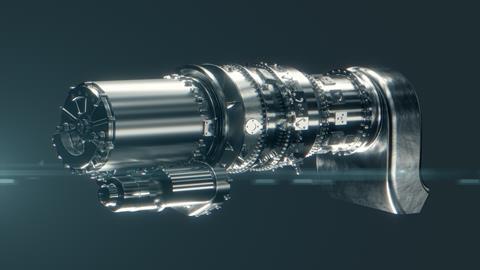Rolls-Royce has provided few details about the development timeline of its new turbogenerator technology but says the initial hybrid-electric system it tests will be sized to deliver output of 800kW.
The propulsion specialist revealed at the ILA Berlin show on 22 June that it was working on the new product, which includes a new small turbine engine at its core.

It says the technology is scalable to deliver between 500-1,200kW and increase the range offered by a new generation of electric vertical take-off and landing, short take-off and landing, and commuter aircraft with up to 19 seats.
Frik-Jan Kruger, Rolls-Royce Deutschland Electrical site lead, says that the first demonstrator system will deliver “around 800kW”.
R-R has run tests in the UK of a much larger turbogenerator – the AE 2100-equipped PGS-1 – which delivered 2MW at peak. However, that would be sufficient to power a 50-seat aircraft, notes Dr Stefan Breunig, head of strategy at Rolls-Royce Electrical.
Breunig sees the system, deployed in a series hybrid configuration on smaller aircraft, as eventually paving the way for higher power applications.
“It will allow us to develop and mature that technology and scale it up and apply it multiple aircraft and segments,” he says.
Kruger notes that as most 19-seaters travel no more than 170nm (314km), the proposed system “captures a huge amount of use cases”.
While the manufacturer has previously run demonstrations of a turbogenerator based around its M250 turboshaft, development of a new turbine engine was seen as vital to the overall effort.
“We learned an incredible amount from the [M250 demonstrator] and that has been fed into the requirement set for this new programme,” says Kruger.
A new engine will be “fully optimised and fully integrated”, he adds and will incorporate “technology from our large gas turbines”, including 3D aerodynamics in the compressor and turbine, the latest cooling technology, and modern materials.
In addition, whole system integration will allow R-R to maximise the power density and efficiency of the turbogenerator.
Similarly, R-R thinks the system will not be suited to aircraft conversion programmes, believing that “the best solution comes when you deliver a new platform with a new airframe and propulsion system that are designed for each other,” says Kruger; for small fixed-wing aircraft, that could include a distributed propulsion architecture.
A possible switch to hydrogen over time has also been baked into the design, he says: ”The fundamental research has been done to ensure future compatibility with hydrogen.” Modifications to the combustor and the fuel system would be required, he notes.
R-R has not released a development timeline for the technology, and is also staying silent on whether it has already secured a launch platform for the product, saying only that it has seen “potential interest” from customers.

























